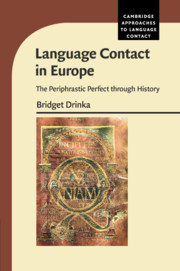Book contents
- Frontmatter
- Contents
- Series Editor's Foreword
- Acknowledgments
- Abbreviations, Based on the Leipzig Glossing Rules
- 1 Language Contact in Europe: The Periphrastic Perfect through History
- 2 Languages in Contact, Areal Linguistics, and the Perfect
- 3 The Perfect as a Category
- 4 Sources of the Perfect in Indo- European
- 5 The Periphrastic Perfect in Greek
- 6 The Periphrastic Perfect in Latin
- 7 The Charlemagne Sprachbund and the Periphrastic Perfects
- 8 The Core and Peripheral Features of the Romance Languages
- 9 The Early Development of the Perfect in the Germanic Languages
- 10 The Semantic Shift of Anterior to Preterite
- 11 The Balkan Perfects: Grammaticalization and Contact
- 12 Byzantium, Orthodoxy, and Old Church Slavonic
- 13 The l- perfect in North Slavic
- 14 Updating the Notion of Sprachbund: New Resultatives and the Circum- Baltic “Stratifi ed Convergence Zone”
- 15 The have Resultative in North Slavic and Baltic
- 16 Conclusions
- Notes
- Bibliography
- Index
2 - Languages in Contact, Areal Linguistics, and the Perfect
Published online by Cambridge University Press: 23 February 2017
- Frontmatter
- Contents
- Series Editor's Foreword
- Acknowledgments
- Abbreviations, Based on the Leipzig Glossing Rules
- 1 Language Contact in Europe: The Periphrastic Perfect through History
- 2 Languages in Contact, Areal Linguistics, and the Perfect
- 3 The Perfect as a Category
- 4 Sources of the Perfect in Indo- European
- 5 The Periphrastic Perfect in Greek
- 6 The Periphrastic Perfect in Latin
- 7 The Charlemagne Sprachbund and the Periphrastic Perfects
- 8 The Core and Peripheral Features of the Romance Languages
- 9 The Early Development of the Perfect in the Germanic Languages
- 10 The Semantic Shift of Anterior to Preterite
- 11 The Balkan Perfects: Grammaticalization and Contact
- 12 Byzantium, Orthodoxy, and Old Church Slavonic
- 13 The l- perfect in North Slavic
- 14 Updating the Notion of Sprachbund: New Resultatives and the Circum- Baltic “Stratifi ed Convergence Zone”
- 15 The have Resultative in North Slavic and Baltic
- 16 Conclusions
- Notes
- Bibliography
- Index
Summary
Considerable controversy has recently arisen concerning the validity of the notion of the Sprachbund: Campbell (2006: 2) declares that “linguistic areas boil down merely to a study of local linguistic borrowing and its history, and little else”; Stolz (2006: 36; 45) concludes that Sprachbünde are “projections from the minds of linguists.” He excludes geography and culture as criteria to be used for judging the existence of a Sprachbund, and sees the use of the “isogloss-first” method, using the geolinguistic distribution of a feature to assess the extent of a Sprachbund, as uninformative. Should we, then, as Stolz (2006: 46) recommends, “either strip the term of its unwelcome and much too suggestive connotations or abolish it for good”? Or is there still reason to retain the notion as a descriptor of a real phenomenon? This chapter argues that there is, indeed, value in preserving the concept of the linguistic area, but that it will require substantial updating. What is proposed here is a more dynamic, three-dimensional depiction of the linguistic area, as embodied in the concept of a “Stratified Convergence Zone.”
This chapter begins with a brief synopsis of earlier work on contact and areal linguistics, followed by an overview of new empirical approaches, including the EUROTYP and ensuing projects. Finally, it presents the model of a new view of the Sprachbund, as a Stratified Convergence Zone.
Languages in Contact: Foundations
The study of languages in contact, once relegated to the periphery of linguistic inquiry, has recently come to be recognized as a subdiscipline with robust explanatory power, positioned between the disciplines of historical linguistics and sociolinguistics and firmly linked to empirical methodology. Among the earliest linguistic models to represent contact as significant was Johannes Schmidt's (1872) renowned Wellentheorie ‘Wave Theory,’ alongside the work of Hugo Schuchardt (1883, 1884), which helped establish the study of pidgins and creoles. Kristian Sandfeld's (1930) classic Linguistique balkanique accounted for many of the shared innovations in the Balkans as due to the domination of Byzantium and to the influence of the Greek Orthodox Church. In Italy, “Neolinguisti” like Matteo Bartoli (1925) focused on the geographical distribution of innovations, expanding on the explanatory role of centrality and peripherality. In his analysis of the languages of the Pacific Northwest, Boas (1938) showed that innovations could spread across linguistic and cultural borders without impediment.
- Type
- Chapter
- Information
- Language Contact in EuropeThe Periphrastic Perfect through History, pp. 24 - 45Publisher: Cambridge University PressPrint publication year: 2017

